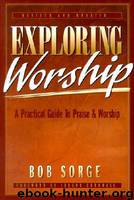Exploring Worship: A Practical Guide to Praise & Worship by Bob Sorge; Judson Cornwall

Author:Bob Sorge; Judson Cornwall
Language: eng
Format: mobi
Tags: Christian Rituals & Practice, Institutions & Organizations, Praise of God, Religion, Worship & Liturgy, Public Worship, Worship
ISBN: 9780962118517
Publisher: Oasis House
Published: 1987-04-13T22:00:00+00:00
CHAPTER 8
THE ART OF LEADING WORSHIP
This chapter speaks of the “art” of leading worship because it is a learned ability. Worship leaders do not spring up overnight. Just as a preacher improves in his skills of communication, and a teacher learns through experience to grow in effectiveness, so too can a worship leader expect to improve with time and practice. In this section we will explore many of the dynamics of leading worship. Suggestions and ideas will be presented which are intended to help worship leaders in the practical implementation of praise and worship.
THE NEED FOR A WORSHIP LEADER
Every situation may not call for a worship leader. In some gatherings, such as home prayer meetings, the group can feasibly have a short time of praise and worship without having an appointed worship leader. If a group is able to function without a worship leader, though, it is because of the small number of participants. Any large gathering must almost always have a designated leader, and even in small group contexts it is usually desirable to have one person responsible for directing the singing. A leader will bring focus and direction to the time of praise, whereas meetings that are completely “open” for all to initiate a song can meander without any apparent purpose or can even become disorderly.
Congregational singing demands that a worship leader be appointed. Sheep need to follow; without a leader they wander aimlessly. Proper leadership is essential for maintaining unity within a group. Without leadership, congregational singing will be haphazard and will never crescendo to a zenith. When a worship leader plans a worship service, all the songs will flow together according to the thoughts of that one leader. If many people lead out in songs, with each song initiated from a different mindset and perspective, the service will continually be shifting in emphasis and direction. By following the direction of one leader, the service is focused, and there is strength in the consequent unity within the congregation.
A worship leader also unites the musicians and congregation rhythmically. A steady and consistent rhythm is essential for a smooth flow in worship, so there must be one person who is authorized to determine and maintain the rhythm for the songs. Sometimes that can be the pianist or the drummer, but usually it is the worship leader. Also, since some songs have tempo changes from the verse to the chorus, an appointed leader establishes the new tempo. He will also indicate holds wherever they might occur. Since there are many things for which he is responsible, his position is strategic to the flow of worship in a church.
QUALIFICATIONS OF A WORSHIP LEADER
The standards and expectations for worship leaders will naturally vary from church to church. In some churches, being on the pastoral staff means being asked to lead worship. In other churches, if one is an elder or a member of the church board, one has fulfilled the sole requirement for this function. But if the effectiveness of the worship
Download
This site does not store any files on its server. We only index and link to content provided by other sites. Please contact the content providers to delete copyright contents if any and email us, we'll remove relevant links or contents immediately.
Joan of Arc by Mary Gordon(3987)
Victory over the Darkness by Neil T. Anderson(2784)
The Gnostic Gospels by Pagels Elaine(2445)
Devil, The by Almond Philip C(2249)
The Nativity by Geza Vermes(2153)
The Psychedelic Gospels: The Secret History of Hallucinogens in Christianity by Jerry B. Brown(2097)
Going Clear: Scientology, Hollywood, and the Prison of Belief by Lawrence Wright(1912)
Going Clear by Lawrence Wright(1897)
A TIME TO KEEP SILENCE by Patrick Leigh Fermor(1813)
Barking to the Choir by Gregory Boyle(1749)
Old Testament History by John H. Sailhamer(1734)
Augustine: Conversions to Confessions by Robin Lane Fox(1716)
A History of the Franks by Gregory of Tours(1655)
A Prophet with Honor by William C. Martin(1647)
The Bible Doesn't Say That by Dr. Joel M. Hoffman(1623)
The Knights Templar by Sean Martin(1610)
by Christianity & Islam(1580)
The Amish by Steven M. Nolt(1509)
The Source by James A. Michener(1506)
